Small saloons aren’t exactly the flavour of the month in the UK car market. While drivers in nations such as India and China are massive fans of these cars, we largely dispensed with them quite a few years ago – first moving into hatchbacks in the 80s and 90s, and then into SUVs and crossovers.
Such is the public’s apparent disdain for compact saloon cars that, setting aside premium offerings there are only three cars from ‘mainstream’ brands that fit this definition. All three are Japanese, and we’re putting two of them head-to-head with one another – the Honda Civic Saloon (or ‘four-door’ as the brand’s marketing calls it) and the Mazda 3 Saloon.
The Civic Saloon was introduced to the UK range in mid-2018, to fill the gap in Honda’s range left when the Accord saloon departed. Consequently, it’s pitched as a more upmarket offering to the youthful, funky hatch. It’s also significantly longer, and offered with a more limited range of engines and trims.
We’re intimately familiar with the Civic saloon, as this model is one we ran on our long-term fleet since May 2019. It’s a 1.0-litre petrol, fitted with a six-speed manual gearbox and in top-spec EX trim. It costs £25,135.
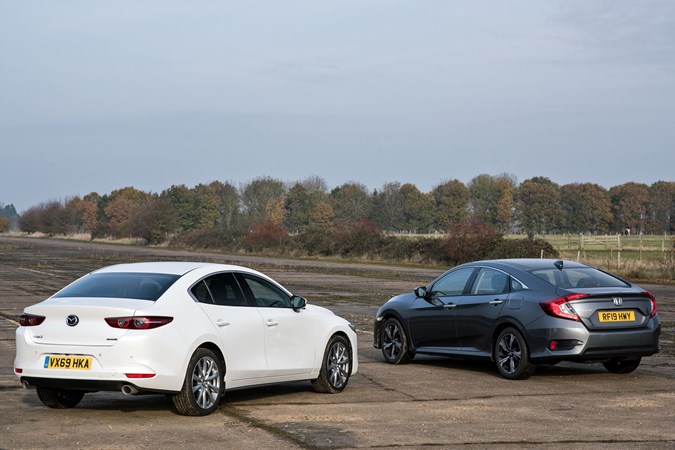
Something to note, however, is that the Civic saloon has now been dropped from the UK model range at the time of writing (January 2020). You’ll still be able to buy one for a while yet – dealers will have some stock, and there will be plenty of used and nearly new examples around. But if you fancied a factory order, you’re unfortunately out of luck.
The 3 Saloon is similarly sized, but can be had with a far wider array of trims, although only a single engine – the firm’s groundbreaking SkyActiv-X compression ignition unit. This produces 180hp, making it significantly more powerful than the Honda’s 129hp – and like the Honda, it’s mated to a six-speed manual gearbox. We have it here in Sport Lux trim, weighing in at £25,425.
The 3’s more powerful engine leaves it wanting for a few items of specification to achieve a similar cash price to the Civic. This Sport Lux model has all the essentials, such as dual-zone climate control, LED lights, heated front seats and a high-tech infotainment system with Apple CarPlay and Android Auto – but does without leather upholstery, a sunroof or the heated rear seats of the Civic.
How practical are they?
This really is the million-dollar question – and the answer’s fairly simple. Neither of these cars are anything like as practical as the hatchbacks they’re based on.
Though overall boot capacity is increased – from 358 to 444 litres in the Mazda’s case, and from 478 to 518 litres for the Civic – the fixed rear window, small load opening and narrow load-throughs mean that these saloon models don’t offer any real flexibility in their load areas.
The Civic’s a particular offender in this case. The standard Civic hatch offers a vast load area with a nice low floor, clever parcel shelf and fold-flat rear seats, but the saloon has a narrow, letterbox-style boot opening, and a sharp-edged and very small load-through when the rear seats are folded.
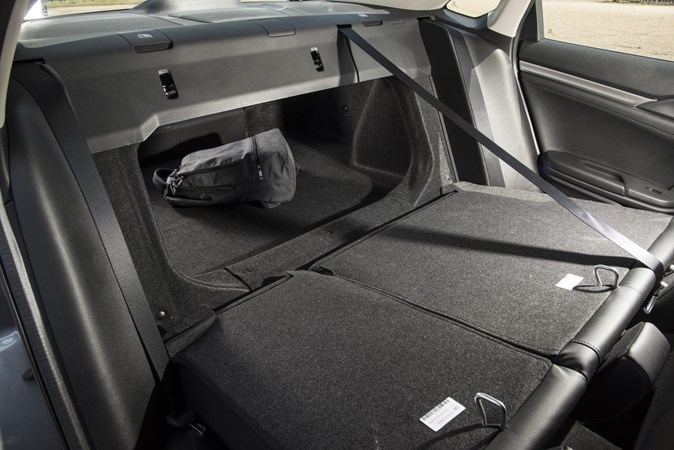
This means that while it is possible to load longer items, they can’t be particularly wide or tall. The unfinished boot ‘ceiling’ and pronounced load lip are just further nails in the Civic’s coffin. While its large capacity means it’s great for holding lots of smaller items, like bags of groceries, you’ll struggle with flat-pack furniture or even large suitcases.
The 3 also suffers with a small boot opening, but fold the rear seats down and they go flatter than the Civic’s. The load-through is also the full width of the interior, making it a much more useful feature. Despite the smaller overall capacity, the 3 has the more practical boot. But, as with the Civic, we’d prefer the outright flexibility of the hatchback.
Use the cars for passengers and you’ll find the Civic has a more capacious rear seat. There’s lots of legroom, decent headroom and plenty of light from the large windows. The 3 is slightly less luxurious, and the sloping roofline can limit headroom. Despite this, the more flexible boot means the Mazda wins on practicality.
What are the interiors like?
From the front doors forward, these cars are largely identical to their hatchback siblings, which is a good thing in both cases. The Mazda’s dashboard is a great example of how we think more manufacturers should operate – with great quality materials throughout, a user-friendly layout and physical controls for everything you want to operate while driving.
It’s based around a high-set infotainment screen, which unusually is not touch-operated. This does make it a trifle difficult to operate Apple CarPlay and Android Auto, as these smartphone interfaces are designed for touchscreens – but it’s a small learning curve, and the rest of the interface works perfectly with the Mazda’s scroll wheel, set conveniently in front of the gear lever.
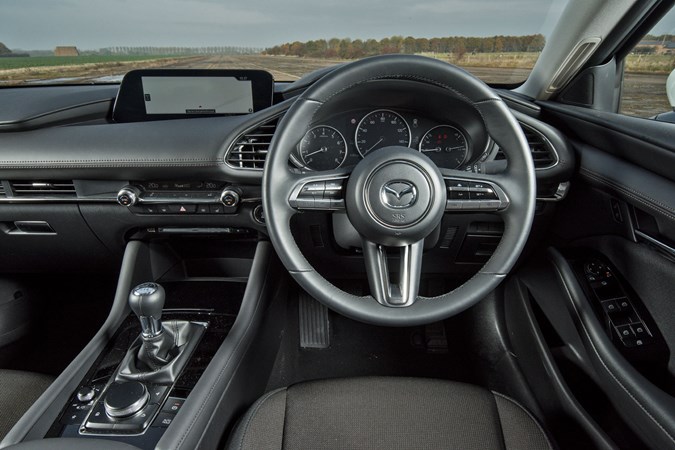
There’s loads of adjustment in the Mazda’s driving position and the seats, though not leather, are very comfortable. There’s also plenty of storage with a deep centre cubby, cupholders positioned well out of the way so they don’t obscure the gear shift, and a good-sized glove box. Quality is the best aspect, though – there are some premium models that could learn a thing or two about how to screw an interior together from the 3.
The Honda Civic has a similarly perfect driving position – nice and low-slung, with lots of adjustment to both seat and steering wheel. Its digital gauges are great, too, providing plenty of information but excelling in clarity, where plenty of models overload you with information.
The dash design isn’t as attractive as the Mazda’s, though, nor is quality as high. The Honda’s design is rather straight-edged, staid and unattractive.
Worse yet, the infotainment is appalling – laden with tricky menus and unintuitive labyrinths of settings. It’s rather telling that during our long-term test of this car there has scarcely been a journey where we’ve not plugged in to use Android Auto and supersede Honda’s interface. It’s the Mazda that wins out here, once more.
What are they like to drive?
The hatchbacks on which these cars are based are excellent to drive, and thankfully that prowess has carried over to the saloons.
The Honda claws several points back here. It’s a tidy handler, with plenty of grip, really nicely weighted steering and a capable chassis.
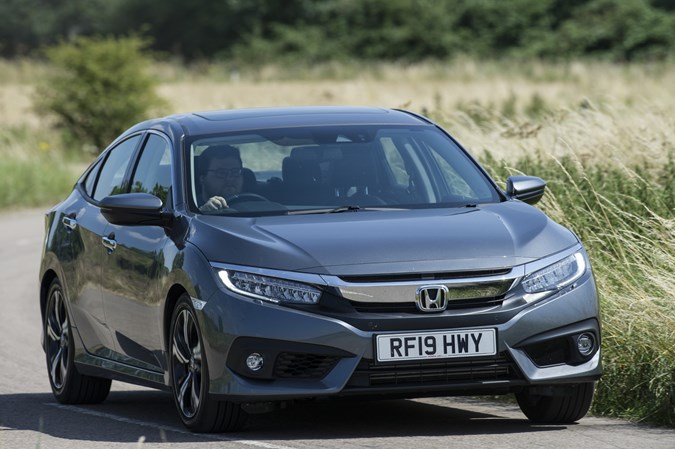
Though its engine is a mere 1.0-litre in capacity with just 129hp, the Civic never feels underpowered. In fact, the dinky motor punches well above its weight, with a strong mid-range and a nice throaty engine note. It’s paired to a lovely, slick manual gearbox, too.
The Mazda is, if anything, even better in the corners than the Civic. It’s set up more for handling than comfort, cornering flatter than the Civic but with less composure over rough road surfaces. Neither car is uncomfortable, though, so it’s very much personal preference.
The Mazda’s six-speed ‘box is even better than the Civic’s, but we have doubts about its engine. Dubbed SkyActiv-X, this motor uses Spark Controlled Compression Ignition (SPCCI) to blend elements of a petrol and diesel engine together. The net result promises diesel-like fuel economy with petrol performance.
In reality, the SPCCI engine feels (and sounds) a lot like a diesel at low revs, and until you breeze past 5,000rpm or so you’d be hard pushed to know this engine had a more than 50hp power advantage over the Civic.
The need to work the engines hard is a common complaint we have with Mazdas, and most will prefer a slug of turbocharged torque in the mid-range on which to coast. While the SkyActiv-X engine is pleasant to drive round town and quiet at motorway speeds, we have to give the edge to the Honda for its greater everyday usability.
How much do they cost?
Both of these cars claim very similar fuel economy figures – the Honda claims 47.1mpg, the Mazda 48.7mpg. Both of these seem achievable, but the need to rev the 3 hard to make progress means that figure may be more difficult to reach.
Six months and thousands of miles with the Honda have returned a consistent figure of around 48mpg, which is impressively more than Honda claims.
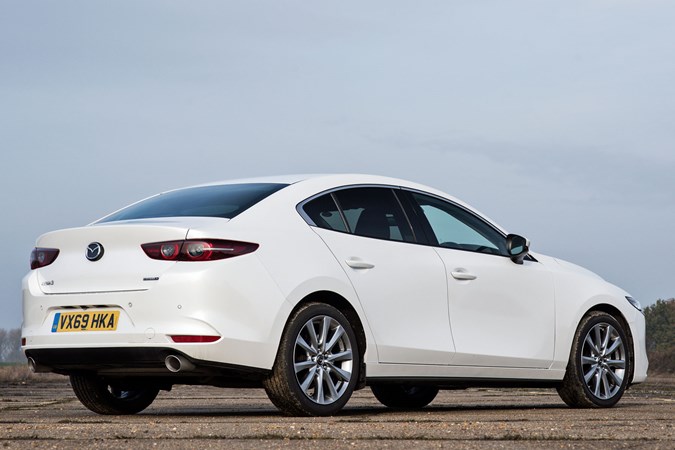
Any fuel economy advantage is wiped out by the finance packages, however. With a deposit of £3,004 over a three-year term, Honda wants £387.57 per month to put a Civic saloon on your driveway.
Compare this with £312.07 per month for the Mazda on a contract of the same length with a £3,000 deposit and that’s not so much a nail in the Honda’s coffin as a layer of glue on top of it.
Rivals
As we said in the introduction, there are only three non-executive – that is to say, not built by a premium brand such as BMW or Audi – saloons on sale in the UK. The third is the Toyota Corolla saloon – which could be an interesting option, especially if you’re interested in its hybrid powertrain.
It also gives the promise of unfailing reliability and user-friendliness, though it’s not as enjoyable to drive as either car here.
We think the biggest rival to either of these cars is the Skoda Octavia. It’s not actually a saloon – its fastback shape hides a large hatch and properly folding rear seats – making it vastly more practical than either the Civic or 3 saloons. It’s also great to drive, and around £25,000 will buy you a really well-specified Sportline model fitted with the powerful and efficient 1.5-litre TSI EVO engine.
A new Octavia’s coming to market in 2020, so you could easily expect some bargain deals on the outgoing model, too.
Verdict
We don’t recommend buying either of these cars over their hatchback siblings – not that you can really buy the Civic anymore anyway. Though some like the looks of a saloon or the supposed increase in refinement, we don’t think they’re worth sacrificing practicality for.
Neither of these cars particularly good value, being more expensive than the models they’re based on.

However, if you simply must indulge, the better car here is the Mazda. With a brilliant chassis, lovely interior and sensible layout, plus those standout looks for the company car park this is genuinely a very good car – impractical boot aside. The trick SkyActiv-X engine isn’t necessarily the step-change we hoped it would be, but nor is it unpleasant.
The Honda has the edge in terms of powertrain, but its staid interior, irritating boot and poor value means that it’s not the best buy here.
Read more:
>> The best hatchbacks to buy 2020
>> Cars coming soon: 2020 Skoda Octavia
Just so you know, we may receive a commission or other compensation from the links on this website - read why you should trust us.
















